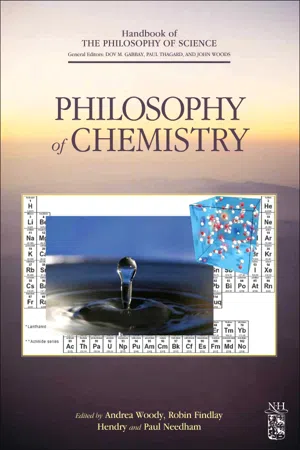Chemistry
Formal Charge
Formal charge is a concept used to determine the distribution of electrons in a molecule. It is calculated by assigning electrons to atoms based on their electronegativity and comparing this with the actual number of electrons in the atom. The formal charge helps in understanding the stability and reactivity of a molecule.
Written by Perlego with AI-assistance
6 Key excerpts on "Formal Charge"
Learn about this page
Index pages curate the most relevant extracts from our library of academic textbooks. They’ve been created using an in-house natural language model (NLM), each adding context and meaning to key research topics.
- Kevin Reel, Derrick C. Wood, Scott A. Best(Authors)
- 2014(Publication Date)
- Research & Education Association(Publisher)
Table 6.1 shows some common exceptions to the octet rule.Table 6.1. Common Exceptions to the Octet RuleTEST TIPReduced octets only occur for elements in the first two periods of the periodic table, whereas expanded octets can only occur for elements in Period 3 or below due to the presence of empty d-orbitals.Formal Charge and Electroneutrality
Despite hard work and persistence, some Lewis structures may not seem to make sense to you. Atoms like nitrogen make four bonds instead of three, as in the case with the nitrate ion; and chlorine, which usually makes one bond, will bond with fluorine to form ClF5 with five bonds and a lone pair on the central atom. How and why does this occur? Formal Charge and electroneutrality is the answer to most of the questions that arise with Lewis structures. Formal Charge is a calculation of the charge on a given atom in a structure based on the number of valence electrons it normally has compared to how many are incorporated in the Lewis structure. The following equation can be used to calculate the Formal Charge on an atom:As you can see, once you know how to calculate the Formal Charge on all of the atoms in a Lewis structure, you can figure out where the negative charge resides on an ion such as nitrate and also ascertain why nitrogen is making four bonds in that structure. More importantly, though, you can use the concept of electroneutrality to determine what is the best, and thereby most probable, Lewis structure. There are a few keys to electroneutrality:- eBook - ePub
- Atef Korchef(Author)
- 2022(Publication Date)
- CRC Press(Publisher)
Electrons are transferred from a metal to a non-metal to form an ionic compound. In the Lewis structure of the ionic compounds, the non-metal (anion) is put in brackets.- Examples:
- The Lewis structure of NaCl is (Figure 8.17 ):
- The Lewis structure of CaF2 is (Figure 8.18 ):
- The Lewis structure of K2 O is (Figure 8.19 ):
FIGURE 8.17 Lewis structure of NaCl.FIGURE 8.18 Lewis structure of CaF2 .FIGURE 8.19 Lewis structure of K2 O.8.4.4 Formal Charge
The Formal Charge (FC) is the charge that an atom would have if the electronegativity differences were ignored. The sum of all Formal Charges must equal the overall charge of the molecule or the ion. The best Lewis structure has the fewest number of non-zero Formal Charges. The FC is given by the following equation:F C = n−Ve −n+N Be −n2Be −where n(Ve− ) is the number of valence electrons,n(NBe− ) is the number of non-bonding electronsand n(Be− ) is the number of bonding electronsNote that the FC can also be given simply by the following equation:F C = n−Ve −b + dwhere n(Ve− ) is the number of valence electrons of the atom, b is the number of bonds (the double bond is counted as two bonds and the triple bonds is counted as three bonds) and d is the number of dots (non-bonded electrons).Practice 8.2 Draw the best Lewis structure of SO4 2−Answer:- Both O and S are non-metals; the bond between S and O is a covalent bond.8 O: [He] 2s2 2p4 , the number of valence electrons in O is six.16 S: [Ne] 3s2 3p4 , the number of valence electrons in S is six.The total number of valence electrons is 4 × 6 + 6 +2 = 32 electrons (24 from 4 O, 6 from S and 2 since SO4 2− is an anion with a charge of −2).
- S is less electronegative than O, so S is the central atom. The trial structure of SO4 2− is (Figure 8.20 ):and the number of electrons shared (used in bonds) is 2 × 4 = 8.
- The remaining valence electrons are 32 − 8 = 24.
- The 24 remaining valence electrons are put on O atoms as lone pairs (Figure 8.21 ). We obtain (structure 1):Sulfur can accommodate more than one octet by using its empty valence d orbital. An alternative Lewis structure of SO4 2− can be given by (structure 2) (Figure 8.22
- eBook - ePub
- Tony Cox(Author)
- 2004(Publication Date)
- Taylor & Francis(Publisher)
− isoelectronic to N, with a nonbonding pair). They are not always written on inorganic valence structures, but the idea is useful in judging the viability of a proposed structure. Some general principles are:• structures without Formal Charges are preferred if possible; • structures with Formal Charges outside the range 1 to 1 are generally unfavorable; • negative Formal Charges should preferably be assigned to more electronegative atoms, positive charges to more electropositive atoms.Thus in N2 O (14), the structure with O− is probably more significant than that with N− . The BF molecule (15) is isoelectronic with CO but the corresponding triple-bonded structure appears very unlikely because it requires Formal Charges B2− and F2+ . The single-bonded form without charges may best describe the bonding.Formal Charge is very different from oxidation state, which is assigned by apportioning electrons in a bond to the more electronegative atom rather than equally (Topic B4 ). Both are artificial assignments, useful in their respective ways, but neither is intended as a realistic judgment of the charges on atoms.LimitationsThe model described in this section can be justified theoretically using the quantum mechanical valence bond theory. Nevertheless, there are many molecules where bonding cannot be described simply in terms of electron pairs localized between two atoms. Diborane is an example. The structure (16) as often drawn appears to have eight bonds and would therefore seem to need 16 valence electrons. In fact, there are only 12 and the molecule is sometimes described as electron deficient. Two pairs of electrons form three-center bonds each linking two boron atoms and a bridging hydrogen, as illustrated in the preferable way of drawing the valence structure in 16 - eBook - ePub
- Dov M. Gabbay, Paul Thagard, John Woods(Authors)
- 2011(Publication Date)
- North Holland(Publisher)
There are two sorts of challenge to the structural view: those due to quantum statistics and electron delocalisation, and those due to substances whose structures cannot informatively be represented by classical valence formulae. The holism objection is that electrons are fermions, which is why molecular wavefunctions are anti-symmetrical with respect to electron permutation. So features of molecular wavefunctions cannot depend on the identities of particular electrons. Understood as pairs of electrons with fixed identities, bonds simply cannot be features of molecular wavefunctions. A related problem concerns electron delocalisation: electron density is ‘smeared out’ over the whole molecule, and so Lewis-style bonds consisting of pairs of electrons held fixed between pairs of atoms are not to be found. These two problems rule out the identification of bonds with Lewis-style static electron pairs, but can be addressed within the structural view. The first problem can be addressed by recognising that a bond must be individuated by the atomic centres it links. In so far as electrons participate physically in the bond (as they must) they do so not as individuals, but as the occupancies of non-arbitrary partitions of the full electronic wavefunction that can be associated with the bond. The second problem can be addressed in similar fashion: some part of the total electron density of the molecule is responsible for the features associated with the bond, and it will be a matter of empirical and theoretical investigation to identify which part. There need be no assumption that it is localised. The structural conception is the heir to the conception of bonds that Lewis inherited from the structure theory of the nineteenth century, but generalised to take account of quantum-mechanical insights.Turning now to the second objection, many substances seem to defy informative representation by valence formulae. Some, like BF3 , PF5 and SF6 , violate the octet rule, according to which the outermost shell of a bonded atom has eight electrons. Such cases were known to Lewis, and constitute objections to the octet rule rather than to the electron-pair bond. For other substances like the boranes (boron hydrides), although Lewis-style valence structures can be drawn (albeit violating the octet rule), these do not reflect known features of their structures like bond lengths and bond angles, which seem to demand distributed multi-centre bonds (see [Gillespie and Popellier, 2001 , Chapter 8 ]). The response to these difficulties is to take a lead from Lewis who, as we saw in Section 2 , recognised that even where they can be written, valence formulae are not always structurally representative. If we regard the concept of a covalent bond as a theoretical notion associated with structural formulae, the applicability of this notion must be delimited by the applicability of structural formulae themselves. Of course there is bonding in paradigm ionic substances like potassium chloride, but their structure and stability is explained electrostatically, without recourse to directional - eBook - ePub
Foundations for Teaching Chemistry
Chemical Knowledge for Teaching
- Keith S. Taber(Author)
- 2019(Publication Date)
- Routledge(Publisher)
From a scientific point of view, bonding can largely be understood in term of the forces between charged particles, and how these tend to bring about more stable (lower energy) configurations. Chemical species that tend to form and stay around are equilibrium arrangements where the charges are configured in a way that they cannot easily be nudged into other more stable arrangements. Such arrangements can be disrupted by inputs of sufficient energy, but once that energy is dissipated, the particles return to stable arrangements.The charged particles concerned could be considered protons and electrons – but (in chemistry) we can usually simplify our thinking about these systems. This is just as well, as teaching about the structure of the methane molecule as an arrangement of 16 protons and 16 electrons would clearly be challenging for most students. Protons are found in nuclei, and although nuclear processes (fission, fusion, radioactivity) are important, they are beyond introductory chemistry (and some would argue actually outside of chemistry completely). So, our methane molecule simplifies somewhat to five nuclei and ten electrons, and a tetrachloromethane molecule to five nuclei and 74 electrons. Yet, often in chemistry, and indeed nearly always in introductory chemistry, we can assume that inner shell electrons remain largely unaffected by chemical change. We can consider chemical systems to be composed of atomic cores (nuclei and inner shell electrons) and the valence electrons from the outer shells associated with those atomic cores. Now our methane molecule is simplified to five atomic cores and eight electrons, and our tetrachloromethane molecule to five atomic cores and 32 electrons (see Figure 10.4 ).Once again, we should keep in mind that we are dealing with models, and models are simplifications, and that simplifications have limited ranges of application before their usefulness breaks down. So, it is not always possible to consider atomic cores as discrete and impervious components of chemical systems. For example, in understanding the bonding in transition metals, there is more going on than metallic bonding involving the outer shell valence electrons being delocalised within an array of atomic cores (i.e., metallic cations). Electrons from the ‘core’ are involved in some degree of bonding interactions as well, explaining some of the properties of these elements (such as high melting temperature). That is a complication that need not be discussed when introducing - eBook - ePub
- Jeffrey Gaffney, Nancy Marley(Authors)
- 2017(Publication Date)
- Elsevier(Publisher)
Electron dot structure a diagram of the valence electrons of an element where the electrons are represented by dots placed around the chemical symbol of the element.Electron shell a group of electron subshells all having the same value of the principal quantum number.Electron subshell a group of electron orbitals with the same value of the principal quantum number.Electronegativity a measure of the tendency of an atom to attract electrons from another atom in a chemical bond.Electronic configuration the assignment of the electrons in an atom to electronic shells, subshells, and orbitals.Excited state higher energy state of an atom arising from the absorption of energy and the transition of electrons to higher orbitals.Ground state the lowest possible energy state of an atom.Groups vertical columns in the Periodic Table of the Elements.Hund's Rule electrons will occupy orbitals individually before filling them in pairs.Ion an atom with an unequal number of protons and electrons.Ionization the process of creating an ion from an uncharged atom.Ionization energy the amount of energy required to remove an electron from an atom in the gas phase.Isotopes atoms with the same number of protons, but different numbers of neutrons in the nucleus.Line emission spectrum the pattern of bright lines separated by darkness emitted by a substance in an excited state as the electrons return to the ground state.





